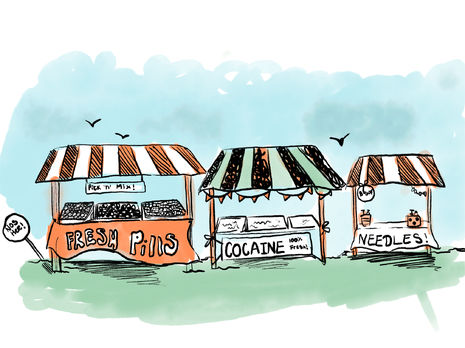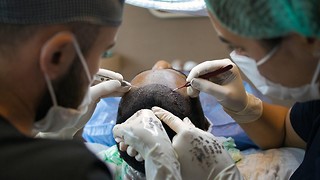Where do Cambridge’s drugs come from?
Claire Gao on drugs, and the story we fail to see beyond the Cambridge bubble

From the Silk Road to Sidgwick Site, recreational drugs have been ubiquitous throughout most societies in human history. And, for as long as university students have been around, suppliers have always had a reliably lucrative market. In recent years, even Cambridge’s centuries of tradition have not spared it the same revolutions undergone by drug markets across the world: digitisation, County Lines, and increasingly potent synthetics.
“Students are funding the unregulated global drug economy”
It is no secret that drug culture runs rampant at universities across the UK, and many are often exposed to drugs for the first time away from home while surrounded by other young people. In Cambridge, where the price for a gram of ketamine is up to £30, whether it’s a one-off dabble or a fresher returning home for Christmas with a pricey addiction and a hefty overdraft, students are funding the unregulated global drug economy.
We are often encouraged to think about the chain of supply for our clothes: their packaging, utilities, and their associated implications for sustainability and human rights. But rarely do students think about how far that bump of coke in the Junction toilets has travelled to get to their nose.
The modern methods of production and transport used by criminal organisations worldwide vary from substance to substance. Farmers of the coca plant, the plant derivative of cocaine which grows naturally in South and Central America, are often blackmailed and threatened to harvest the plant for cartels or armed anti-government militias. Members of these organisations doing the grunt work typically have no other option in a politically and economically unstable region. Much of what eventually becomes cocaine remains in the Americas, but some finds its way across the Atlantic through complex networks.
Drug mules, often vulnerable young people recruited or blackmailed by these cartels, ingest or plug these drugs before travelling into Europe. Your baggie is likely to have made its way through more countries than the average post-A-Level interrailing group, including Albania and the Netherlands. Once in the UK, they are often distributed through gangs from major cities, and for Cambridge that means London.
“Not quite farm to table”
This is where the infamous County Lines operation comes in. The south-eastern region surrounding London, including Cambridgeshire and the home counties, is known as ‘Cunch’. This is where young people from vulnerable backgrounds, recruited by gangs and often under 18, are sent, sometimes without pay and under the guise of having to pay off a debt to their superiors. These carriers are instructed to sell product here, and it’s likely that much of the drugs in circulation in Cambridge have passed through the hands of one of these kids.
Not quite farm to table. At any time during this process, more expensive drugs like cocaine are usually ‘cut’ with cheap filler material to maximise profits. Common bulking agents include Paracetamol, rat poison or even deadly high-potency synthetics.
Over the years, studies have shown that drugs on the market have, on average, gotten stronger with the help of synthetics. This increases profits, but also poses major threats to the user, who may have been used to a low potency and is now at an increased risk of overdose. The rise of chemical research and new formulations from black-market chemists has given way to unprecedented and deadly potency in what would have formally been considered a ‘normal’ dosage for many classes of drugs. Rave-culture 2CB is amongst these new potent synthetics, and spiked or super-strong MDMA pills were the cause of death for some teens at festivals in recent years, marketed with colourful and quirky sweet-like appearances, like pop-culture logos and brands.
Marketing is everything. Once the product has arrived at its supplier, it’s up to them to push as hard as they can. And drug dealers have utilised technology to both gain customers and get them coming back.
“Marketing is everything”
The first digital drug deals started on the dark web. One of the biggest marketplaces was the aptly-named ‘Silk Road’ which launched in 2011, handling transactions in Bitcoin only. The process was so accessible that a German teenager launched his own website ‘Shiny Flakes’ in 2013, dubbed the ‘Amazon for drugs’ (even having a space on the page for customers to review his services). It ran successfully for two years before it was caught by police.
Ten years later, the days of Nokia bricks are largely gone – despite what late-2000s drug awareness adverts or Breaking Bad will tell you – and communication with dealers is more often conducted on WhatsApp, Telegram or in blue on iMessage. I heard from one student at the University of Leeds who got a WhatsApp message from a dealer that they’d sourced her number from a freshers’ group chat. Dealers regularly send customers flashy, sweetshop-esque menus with a liberal dose of emojis and caps lock. Marijuana is branded with names like ‘Mimosa’, ‘Sherbert’ and ‘Sour Apple Killer’.
But it’s a lot less straightforward than just telling people to boycott drugs. Thanks to decades of dependency manufactured by cartels and gangs, the counterproductive War on Drugs and the fact that criminalisation prevents regulation, thousands of people worldwide remain dependent on the drug industry. Falling cocaine prices have had devastating effects on Colombian farmers, and local dealers face harsh punishments from gang leaders if their quota is not met. But as long as the global supply chain remains unregulated and restricted to the black-market, the drugs students get in Cambridge will likely be the products of violent conflict, cut with potentially lethal fillers and simultaneously part of one of the biggest economic industries in the world.
 Features / Meet the Cambridge students whose names live up to their degree9 September 2025
Features / Meet the Cambridge students whose names live up to their degree9 September 2025 News / Student group condemns Biomedical Campus for ‘endorsing pseudoscience’10 September 2025
News / Student group condemns Biomedical Campus for ‘endorsing pseudoscience’10 September 2025 News / Tompkins Table 2025: Trinity widens gap on Christ’s19 August 2025
News / Tompkins Table 2025: Trinity widens gap on Christ’s19 August 2025 News / New left-wing student society claims Corbyn support11 September 2025
News / New left-wing student society claims Corbyn support11 September 2025 Science / Who gets to stay cool in Cambridge?7 September 2025
Science / Who gets to stay cool in Cambridge?7 September 2025









